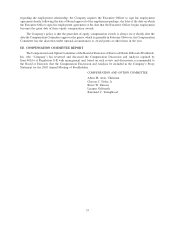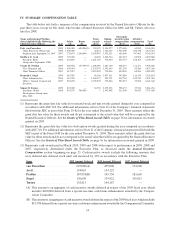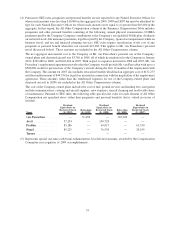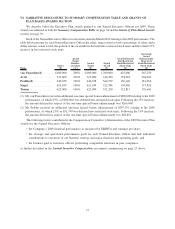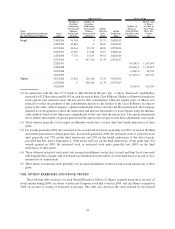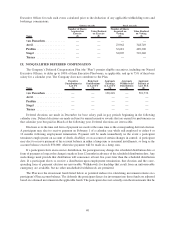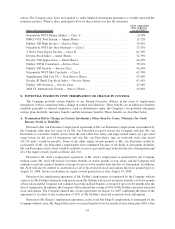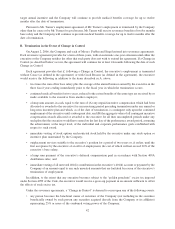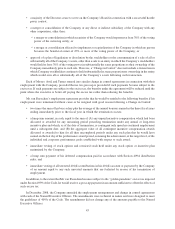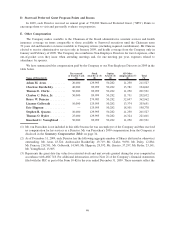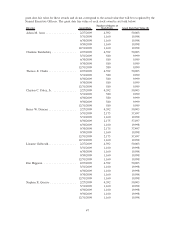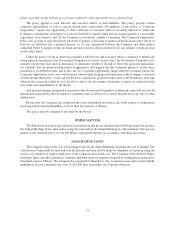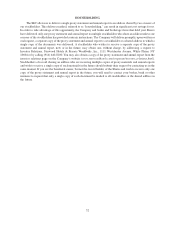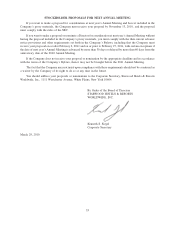Starwood 2009 Annual Report Download - page 52
Download and view the complete annual report
Please find page 52 of the 2009 Starwood annual report below. You can navigate through the pages in the report by either clicking on the pages listed below, or by using the keyword search tool below to find specific information within the annual report.• a majority of the Directors cease to serve on the Company’s Board in connection with a successful hostile
proxy contest;
• a merger or consolidation of the Company or any direct or indirect subsidiary of the Company with any
other corporation, other than:
Oa merger or consolidation in which securities of the Company would represent at least 70% of the voting
power of the surviving entity; or
Oa merger or consolidation effected to implement a recapitalization of the Company in which no person
becomes the beneficial owner of 25% or more of the voting power of the Company; or
• approval of a plan of liquidation or dissolution by the stockholders or the consummation of a sale of all or
substantially all of the Company’s assets, other than a sale to an entity in which the Company’s stockholders
would hold at least 70% of the voting power in substantially the same proportions as their ownership of the
Company immediately prior to such sale. However, a “Change in Control” does not include a transaction in
which Company stockholders continue to hold substantially the same proportionate ownership in the entity
which would own all or substantially all of the Company’s assets following such transaction.
Each of Messrs. Avril and Turner entered into similar change in control agreements in connection with their
employment with the Company, provided that no tax gross-up is provided if such payments become subject to the
excise tax. If such payments are subject to the excise tax, the benefits under the agreement will be reduced until the
point where the executive is better off paying the excise tax rather than reducing the benefits.
Mr. van Paasschen’s employment agreement provides that he would be entitled to the following benefits if his
employment were terminated without cause or he resigned with good reason following a Change in Control:
• two times the sum of his base salary plus the average of the annual bonuses earned in the three fiscal years
ending immediately prior to the fiscal year in which the termination occurs;
• a lump sum amount, in cash, equal to the sum of (A) any unpaid incentive compensation which had been
allocated or awarded for any measuring period preceding termination under any annual or long-term
incentive plan and which, as of the date of termination, is contingent only upon his continued employment
until a subsequent date, and (B) the aggregate value of all contingent incentive compensation awards
allocated or awarded to him for all then uncompleted periods under any such plan that he would have
earned on the last day of the performance award period, assuming the achievement, at the target level, of the
individual and corporate performance goals established with respect to such award;
• immediate vesting of stock options and restricted stock held under any stock option or incentive plan
maintained by the Company;
• a lump sum payment of his deferred compensation paid in accordance with Section 409A distribution
rules; and
• immediate vesting of all unvested 401(k) contributions in his 401(k) account or payment by the Company
of an amount equal to any such unvested amounts that are forfeited by reason of his termination of
employment.
In addition, to the extent that Mr. van Paasschen becomes subject to the “golden parachute” excise tax imposed
under Section 4999 of the Code, he would receive a gross-up payment in an amount sufficient to offset the effects of
such excise tax.
In December 2008, the Company amended the employment arrangements and change in control agreements
with each of the Named Executive Officers. The amendments were technical in nature and were designed to meet
the guidelines of 409A of the Code. The amendments did not change any of the amounts payable to the Named
Executive Officers.
43


